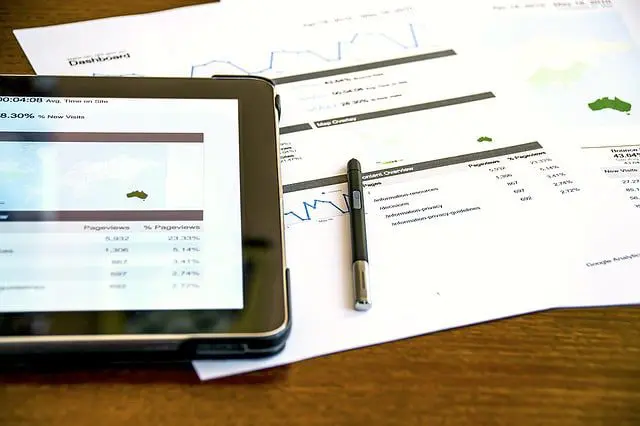Are you a small business owner looking to boost your brand’s visibility and drive qualified leads? If so, you’re probably well aware that marketing is your most valuable tool. However, navigating the world of marketing can be overwhelming, especially without a proper guide. One essential component of a successful marketing campaign is Pay-Per-Click (PPC) advertising.
In this blog, we’ll explore the fundamentals of PPC advertising, including what it is, how it works, and the benefits it offers for your business. Whether you’re a marketing novice or a seasoned entrepreneur, understanding PPC can empower you to leverage this powerful tool and achieve a high return on investment. So, let’s dive in and demystify the world of PPC advertising!

Let’s start at the beginning… What is PPC?
Pay-Per-Click (PPC) advertising is exactly what it sounds like. It’s an online advertising model where businesses pay each time a user clicks on one of their ads. You’ve likely come across PPC in action when you see those “Sponsored” ads or posts on your social media feeds. But what exactly is happening behind the scenes?
One of the most common types of PPC ads is the paid search ad. These are the ads that appear prominently on your Search Engine Results Page (SERP) when you perform an online search using platforms like Google. You’ve probably seen them when searching for local services in your area, looking for nearby coffee shops, or even exploring more specific topics like the best nursing courses or business software solutions.
PPC ads are designed to align with these search terms, also known as keywords, in order to catch the attention of users who are actively seeking the products or services that the advertiser offers. The beauty of PPC is that businesses are only charged when a user actually clicks on their ad, hence the name “pay per click” ads. This makes it a cost-effective approach, as you’re paying specifically for the engagement and potential leads generated.
In addition to paid search ads, there are other forms of PPC advertising, such as remarketing and display advertising. You may have noticed these ads following you around on your social media feed or appearing on websites after you’ve conducted an online search. These ads serve as a way to re-engage with users who have shown previous interest, reinforcing brand awareness and potentially driving conversions.
By leveraging PPC advertising, businesses can strategically target their audience and increase their visibility during relevant searches. It’s a powerful tool for driving traffic, attracting potential customers, and ultimately boosting sales. In the next sections, we’ll explore the intricacies of PPC, including how it works, its benefits, and how it can be integrated into your overall marketing strategy. So, let’s dive deeper into the world of PPC and discover how it can propel your business forward!

The Auction Origins of PPC
PPC advertising operates within a competitive online auction environment where advertisers vie for advertising space through various auction formats. Pay per click means that you only pay when someone clicks on your advert. Since the inception of PPC, several billing variations have emerged, including cost per impression, cost per video view, and more. However, the industry has retained the original name, PPC.
PPC targeting is a powerful aspect of this advertising model. It enables you to select specific audience groups that align with your target customer profile. You can tailor your ads to appear on search engine results pages and website placements that attract users with specific interests, behaviours, demographics, and more. This level of precision targeting ensures that your ads reach the right people at the right time, increasing the likelihood of engagement and conversions.
By leveraging PPC targeting effectively, you can maximise the impact of your advertising campaigns and drive valuable traffic to your business. In the following sections, we’ll delve deeper into the mechanics of PPC, explore its benefits, and provide insights on how you can optimise your PPC strategy. So, let’s continue our journey and unlock the potential of PPC advertising!
Let’s talk about what PPC isn’t!
The previous paragraph might lead you to believe that PPC is the ultimate solution to all your marketing needs. It has the power to place your products, services, and brand directly in front of the eyes of your target audience. However, it’s important to understand that PPC should not be viewed as a standalone, all-encompassing solution. Instead, think of it as an impactful opening salvo that can be followed up with complementary measures. PPC is just one tool within a comprehensive marketing repertoire, and it serves a very specific function. To truly harness the potential of PPC, it is advisable to seek the guidance of an experienced agency. They can help you capitalise on the surge of awareness, consideration, and conversion that PPC can generate, integrating it seamlessly into your broader marketing strategy.
How does PPC work?
How does PPC Work? When it comes to paid searches, PPC operates in a similar fashion to an eBay auction. However, instead of bidding on physical items, advertisers are bidding on awareness. Contrary to popular belief, simply throwing more money at search engines doesn’t guarantee that your ads will outshine those of your competitors on Search Engine Results Pages (SERPs).
All ads, regardless of whether they come from small independent businesses or corporate giants, go through a process called the Ad Auction. This automated process is employed by search engines to assess the relevance and validity of ads, positioning paid ads on SERPs based on their own criteria. It’s a level playing field where the search engine evaluates each ad’s quality and determines its placement accordingly.
This means that simply having a larger budget doesn’t guarantee better visibility. The ad’s quality and relevance play a crucial role in determining its position on SERPs. It’s not just about how much you are willing to pay, but also how well your ad aligns with the search engine’s evaluation criteria.
In the next sections, we’ll explore the role of keywords and delve into strategies for optimising your PPC campaigns to ensure maximum visibility and effectiveness. So, let’s continue our journey into the world of PPC and unlock the key to successful advertising!

All about keywords
But how do Ad Auctions determine which ads are relevant to user searches? The answer lies in the use of relevant words, known as keywords, that trigger or display the appropriate ads. Whether you’re searching for pizza in Manchester, a hairdresser in Ealing, or a casting agent in Birmingham, your choice of keywords will help connect you with the services you need.
It’s important to note that not all keywords are created equal. Some keywords have higher competition, meaning that more advertisers are vying for them, which can drive up the cost of advertising. For small businesses, it’s often wise to target low-competition keywords that provide a better chance of finding your niche audience and maximising your budget.
Additionally, it’s crucial to consider the intent behind your chosen keywords. Some keywords are more intent-rich, indicating that users are actively looking to take a specific action. These conversion-focused keywords have a lower search volume but higher intent, making them valuable for driving targeted actions. On the other hand, brand-building keywords are used to increase overall brand visibility and drive traffic to your website.
An effective PPC strategy involves finding the right balance between brand-building and conversion keywords. By strategically selecting and prioritising your keywords, you can optimise your campaign’s performance and achieve the desired results.
In the following sections, we’ll explore keyword research techniques, keyword match types, and strategies for maximising the effectiveness of your PPC keywords. So, let’s dive deeper into the world of keyword optimisation and enhance the success of your PPC campaigns!

The Benefits of PPC
Certainly! Here is a list of benefits of using PPC advertising, including the ones provided and additional benefits, ranked by order of importance:
Measurable and Trackable:
PPC campaigns provide detailed data and analytics that allow you to measure the effectiveness of your ads. You can track key performance metrics, such as impressions, clicks, conversions, and return on investment (ROI), to assess the success of your campaign.
Laser-Focused Targeting:
PPC allows you to precisely target your audience based on specific demographics, interests, locations, and search terms. This laser-focused targeting ensures that your ads reach the right people who are more likely to be interested in your products or services.
Quick Results:
Unlike organic marketing efforts, PPC advertising can generate immediate results. By launching a well-optimised campaign, you can quickly increase brand visibility, attract qualified traffic, and generate conversions in a relatively short period of time.
Level Playing Field:
PPC enables businesses of all sizes to compete in the online advertising space. Even if you are a small business with limited operational experience, you can effectively engage prospects and leads based on the merits of your ads, without being overshadowed by larger competitors.
Integration with Other Marketing Channels:
PPC can be seamlessly integrated into your overall marketing strategy. It complements other digital marketing channels, such as SEO and content marketing, by driving targeted traffic to your website and amplifying your brand’s online presence.
Valuable Insights for Strategy:
PPC platforms, like Google Ads, provide valuable data and insights into the performance of your keywords, ads, and campaigns. This information can inform your ongoing marketing efforts, allowing you to refine your strategies, optimise your content, and improve your organic search results.
Cost Control:
PPC advertising provides flexibility in budget management. You have full control over how much you spend on ads, allowing you to set daily or monthly budgets that align with your financial resources and marketing goals.
Enhanced Brand Exposure:
PPC ads appear prominently on SERPs, increasing your brand’s visibility and exposure to potential customers. This increased visibility contributes to brand recognition, recall, and trust.
Geographical Targeting:
PPC allows you to target specific geographical locations, ensuring that your ads are displayed to users in the regions where you operate or want to expand your business. This localised targeting helps you reach your target audience more effectively.
A/B Testing and Optimisation:
PPC platforms provide options for A/B testing, enabling you to experiment with different ad variations, landing pages, and calls to action. This iterative process of testing and optimisation helps improve the performance and conversion rates of your campaigns.
Remember, the order of importance may vary depending on the specific needs and goals of your business.
The Growth of PPC Platforms- 1st party and third party.
Initially, we witnessed the introduction of PPC platforms like Google Ads, Facebook Ads, Twitter Ads, and LinkedIn Ads. These platforms revolutionised online advertising, providing businesses with targeted advertising opportunities across diverse digital channels.
More recently, Pinterest has joined the PPC landscape, offering its own PPC platform. This expansion provides businesses with yet another avenue to reach their target audience and promote their products or services effectively.
Interestingly, even online service marketplaces like Fiverr.com have incorporated PPC services. On platforms like Fiverr, sellers can showcase their advertisements to buyers who are actively searching for specific services. While organic listings on such marketplaces are determined through natural signals, sponsored ads allow sellers with less experience to develop their online presence within that job marketplace.
This proliferation of PPC platforms signifies the increasing demand for effective advertising solutions across a wide range of online platforms. It provides businesses with more options and opportunities to connect with their target audience, increase brand exposure, and drive conversions.
In the following sections, we will explore these PPC platforms in more detail, highlighting their unique features and discussing how businesses can leverage them to enhance their marketing strategies. So, let’s delve deeper into the evolving world of PPC platforms and discover new avenues for promoting your brand and reaching your marketing goals.
Google Display Network
It is possible to run PPC display advertising on millions of websites through the Google network. For example, you can run adverts next to related content of online newspapers such as The Times, Mirror.co.uk, Independent.co.uk, Daily Star, The Guardian, The Sun, and more.
You can also show adverts to your past website visitor remarketing audience, but only on certain websites. Additionally, you can combine keywords to only show ads on specific websites, as well as on content and articles related to your offering.
Running PPC display advertising on the Google network offers extensive opportunities to reach your target audience effectively. By placing ads alongside relevant content on reputable websites, you can increase brand visibility and attract potential customers.
It’s important to note that some websites may have audience size restrictions to protect user privacy. This is in addition to using data that is part of an anonymous aggregate, ensuring privacy and confidentiality.
For instance, popular news websites like the BBC or various newspaper publications provide advertising spaces that can be monetised through PPC platforms. These platforms enable businesses to connect with their target audience by selling ad spaces directly to advertisers or participating in third-party exchange programs such as Google AdSense.
In the upcoming sections, we will explore PPC advertising audiences in more detail, including shared interests, demographics, and behavioural characteristics. We will also discuss effective targeting strategies to optimise your PPC campaigns. So, let’s delve deeper into the world of PPC audiences and discover how to effectively reach your target customers through precise targeting and strategic advertising placement.
The Future of PPC Platforms?
The future of PPC advertising systems holds exciting possibilities as technology continues to advance and consumer behaviour evolves. Here are some potential trends and developments to look out for:
1. Enhanced Automation:
PPC platforms are likely to become more sophisticated with increased automation. Machine learning algorithms can optimise bidding strategies, ad placements, and targeting, resulting in more efficient and effective campaigns.
2. Integration of AI and Voice Search:
As voice search becomes increasingly prevalent, PPC systems may incorporate artificial intelligence (AI) to interpret and respond to voice queries. Advertisers will need to adapt their strategies to optimise for voice-based interactions and capture this emerging market.
3. Cross-Channel Integration:
PPC platforms will continue to evolve to offer better integration with other marketing channels. This allows businesses to create cohesive advertising campaigns that span multiple platforms, including search engines, social media, mobile apps, and more.
4. Advanced Targeting Capabilities:
PPC systems will likely provide more advanced targeting options, allowing advertisers to reach highly specific audiences based on demographics, interests, behaviours, and even real-time contextual data. This enables businesses to deliver personalised and relevant ads to their target customers.
5. Emphasis on User Experience:
User experience will play a crucial role in the future of PPC advertising. Advertisers will focus on creating engaging, non-intrusive ad experiences that provide value to users, resulting in higher engagement rates and improved campaign performance.
6. Increased Focus on Privacy and Data Protection:
With growing concerns about data privacy, PPC platforms will continue to adapt to stricter regulations and consumer expectations. Advertisers will need to ensure they comply with privacy standards while leveraging data responsibly to target their ads effectively.
7. Integration of Augmented Reality (AR) and Virtual Reality (VR):
As AR and VR technologies advance, PPC systems may incorporate immersive ad experiences. Advertisers can leverage these technologies to showcase products, provide interactive demos, or enhance brand storytelling, creating memorable experiences for users.
8. Emphasis on Video Advertising:
Video ads are gaining popularity, and PPC systems will likely place greater emphasis on video advertising capabilities. Advertisers can leverage video platforms like YouTube and social media channels to engage audiences effectively through compelling visual content.
9. Continued Growth of Mobile Advertising:
Mobile usage continues to rise, and PPC platforms will further optimise for mobile ads. Advertisers will need to focus on mobile-friendly designs, fast-loading landing pages, and strategies tailored to mobile users’ preferences and behaviours.
10. Increasing Integration of E-commerce and PPC:
PPC systems may further integrate with e-commerce platforms, enabling businesses to create seamless shopping experiences within the ad itself. Features like product showcases, pricing information, and one-click purchasing can enhance the conversion process.
As technology evolves and consumer behaviour shifts, the future of PPC advertising systems will continue to evolve to meet the needs of businesses and consumers alike. Advertisers who stay informed and adapt their strategies to leverage these advancements will be well-positioned to succeed in the dynamic world of digital advertising.
Conclusion
In conclusion, PPC advertising offers immense opportunities for businesses to effectively promote their products and services in the digital landscape. By leveraging the power of PPC, businesses can reach their target audience, generate quick results, and achieve their marketing goals.
Throughout this blog, we have explored the key aspects of PPC advertising, including its definition, how it works, and the benefits it provides. We have delved into the importance of strategic keyword selection, the role of ad auctions in determining ad visibility, and the integration of PPC with other marketing channels.
Moreover, we have discussed the numerous advantages of PPC advertising, such as its measurability and trackability, its ability to level the playing field for businesses of all sizes, and its integration with other digital marketing strategies. We have also highlighted the laser-focused targeting capabilities of PPC and how it can inform ongoing marketing efforts through valuable data insights.
Looking towards the future, we anticipate the continued growth and evolution of PPC advertising systems. Enhanced automation, integration of AI and voice search, cross-channel integration, advanced targeting capabilities, and an emphasis on user experience are just a few of the exciting trends that we can expect to see.
As technology advances and consumer behaviour evolves, businesses must stay informed and adapt their PPC strategies to leverage these developments. The future of PPC advertising holds great potential for businesses to connect with their target audience, drive conversions, and stay ahead in the dynamic world of digital advertising.